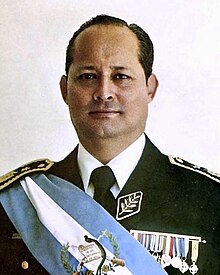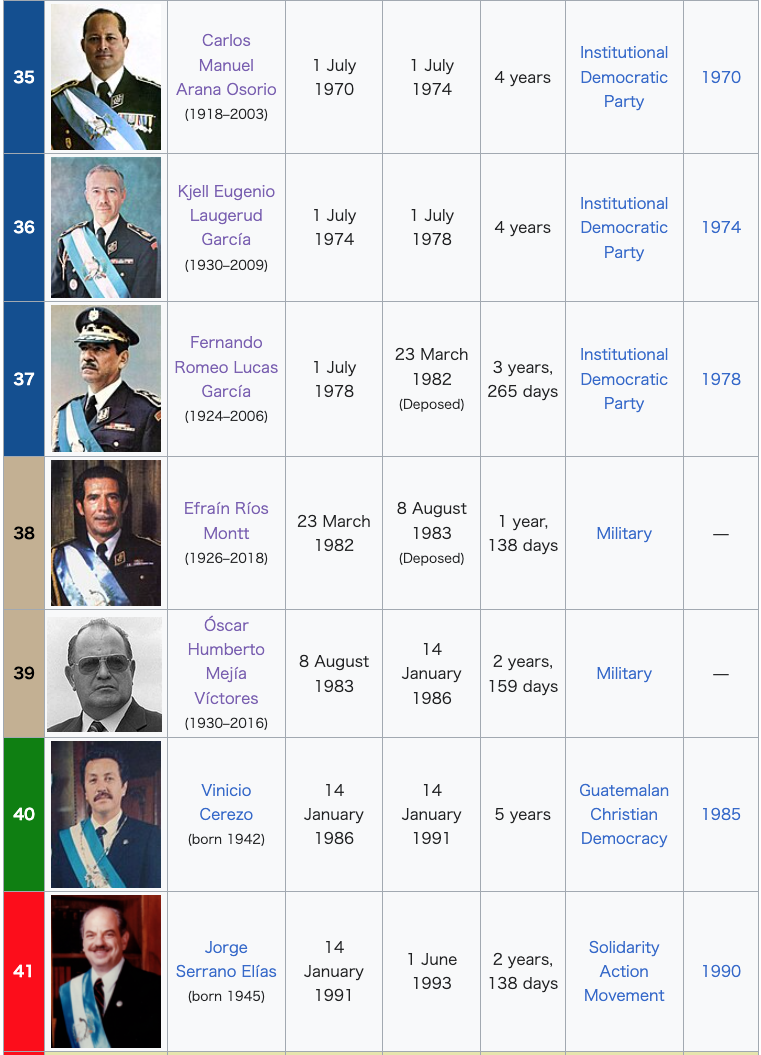
カルロス・マヌエル・アラナ・オソリオ
Carlos Manuel Arana Osorio, 1918-2003
☆ カルロス・マヌエル・アラナ・オソリオ(Carlos Manuel Arana Osorio、1918年7月17日[1] - 2003年12月6日)は、1970年から1974年までグアテマラ大統領を務めた軍人、政治家。アラナ政権は、政治的・軍事的敵対者や一般犯罪者に対す る拷問、失踪、殺害を強行した。アラナはサンタ・ロサ県のバルベレナ生まれ。陸軍大佐としてサカパとイザバルでの反乱活動を監督し、1966年から1968年にかけて数千人が軍によって 殺害された。1970年7月、一般に「透明性がない」とされる選挙プロセスを経て、法秩序問題の取り締まりと安定を約束する綱領を掲げて大統領に就任。副大統領はエドゥアルド・カセレスであった。1970年11月、アラナは「包囲状態」を敷き、反乱対策を強化した。アラナ政権は、ゲリラとの戦いの中で、 深刻な人権侵害を行い、政府主催の "死の部隊 "を含む国家的テロリズムを行使した。治安部隊は、政敵、学生指導者、ゲリラのシンパ容疑者、労働組合員を定期的に拘束、失踪、拷問、超法規的処刑した。 アラナ政権は、米国から武器、技術支援、軍事顧問など大規模な軍事支援を受けた。グアテマラ人権委員会は、アラナ政権下で20,000人のグアテマラ人が 殺害されたか「失踪」したと推定している。フリーメーソンであったカルロス・アラナは、1970年代から1980年代にかけてグアテマラの政治を支配した一連の制度民主党軍事支配者の最初の人物であった。
| Carlos
Manuel Arana Osorio (July 17, 1918[1] – December 6, 2003) was a
military officer and politician who served as president of Guatemala
from 1970 to 1974. His government enforced torture, disappearances, and
killings against political and military adversaries, as well as common
criminals. Arana was born in Barberena, in the department of Santa Rosa. A Colonel in the Army, he oversaw counterinsurgency efforts in Zacapa and Izabal, where thousands were killed by the military from 1966 to 1968. In July 1970, he became president following an electoral process generally considered "non-transparent" on a platform promising a crackdown on law-and-order issues and stability; his vice president was Eduardo Cáceres. In November 1970, Arana imposed a "State of Siege," followed by heightened counterinsurgency measures. His government committed severe human rights violations and used state terrorism in its war against the guerrillas, including government-sponsored "death squads." Security forces regularly detained, disappeared, tortured, and extrajudicially executed political opponents, student leaders, suspected guerrilla sympathizers, and trade unionists. Arana's government received large-scale military support from the United States, including weapons, technical support, and military advisors. The Guatemalan Human Rights Commission estimated that 20,000 Guatemalans were killed or "disappeared" under the Arana administration.[2] Carlos Arana, a freemason, was the first of the string of Institutional Democratic Party military rulers who would dominate Guatemalan politics in the 1970s and 1980s (his predecessor, Julio Méndez Montenegro, while dominated by the army, was a civilian). He also served as the ambassador to Nicaragua. |
カ
ルロス・マヌエル・アラナ・オソリオ(Carlos Manuel Arana Osorio、1918年7月17日[1] -
2003年12月6日)は、1970年から1974年までグアテマラ大統領を務めた軍人、政治家。アラナ政権は、政治的・軍事的敵対者や一般犯罪者に対す
る拷問、失踪、殺害を強行した。 アラナはサンタ・ロサ県のバルベレナ生まれ。陸軍大佐としてサカパとイザバルでの反乱活動を監督し、1966年から1968年にかけて数千人が軍によって 殺害された。1970年7月、一般に「透明性がない」とされる選挙プロセスを経て、法秩序問題の取り締まりと安定を約束する綱領を掲げて大統領に就任。 副大統領はエドゥアルド・カセレスであった。1970年11月、アラナは「包囲状態」を敷き、反乱対策を強化した。アラナ政権は、ゲリラとの戦いの中で、 深刻な人権侵害を行い、政府主催の "死の部隊 "を含む国家的テロリズムを行使した。治安部隊は、政敵、学生指導者、ゲリラのシンパ容疑者、労働組合員を定期的に拘束、失踪、拷問、超法規的処刑した。 アラナ政権は、米国から武器、技術支援、軍事顧問など大規模な軍事支援を受けた。グアテマラ人権委員会は、アラナ政権下で20,000人のグアテマラ人が 殺害されたか「失踪」したと推定している[2]。 フリーメーソンであったカルロス・アラナは、1970年代から1980年代にかけてグアテマラの政治を支配した一連の制度民主党軍事支配者の最初の人物で あった(彼の前任者であるフリオ・メンデス・モンテネグロは、軍に支配されていたとはいえ、文民であった)。ニカラグア大使も務めた。 |
| Early life Arana was born in Barberena, in the department of Santa Rosa, on July 17, 1918. He is the nephew of the former head of the Guatemalan armed forces, Francisco Javier Arana, who was one of the three members of the revolutionary junta that governed Guatemala from 20 October 1944 to 15 March 1945 during the early part of the Guatemalan Revolution. Carlos Arana Osorio joined the military and became an officer. He was also an anti-communist politician and freemason. In 1955, he was appointed director of a Polytechnic School that the government reopened following the 1954 Guatemalan coup d'état.[3] |
生い立ち アラナは1918年7月17日、サンタ・ロサ県のバルベレナで生まれた。グアテマラ革命の初期、1944年10月20日から1945年3月15日までグア テマラを統治した革命団の3人のメンバーのひとりであった。カルロス・アラナ・オソリオは軍に入り、将校となった。反共産主義の政治家であり、フリーメー ソンでもあった。1955年、グアテマラ政府が1954年のクーデター後に再開したポリテクニック学校の校長に任命された[3]。 |
| Military career Main articles: Guatemalan Civil War and Julio César Méndez Montenegro In 1964 and 1965, the Guatemalan Armed Forces began engaging in counterinsurgency actions against the MR-13 in eastern Guatemala. In February and March 1964, the Guatemalan Air Force began a selective bombing campaign against MR-13 bases in Izabal, which was followed by counterinsurgency sweeps in the neighboring province of Zacapa under the code-name "Operation Falcon" in September and October 1965.[4] These operations were supplemented by increased U.S. military assistance. Beginning in 1965, the U.S. government sent Green Berets and CIA advisers to instruct the Guatemalan military in counterinsurgency (anti-guerrilla warfare). In addition, U.S. police and "Public Safety" advisers were dispatched to reorganize the urban security structures.[5][full citation needed] In a clandestine operation in March 1966, a total of thirty Partido Guatemalteco del Trabajo (PGT, Guatemalan Party of Labor) associates were seized, detained, tortured, and executed by the security forces. When law students at the University of San Carlos used legal measures (such as habeas corpus petitions) to require the government to present the detainees in court, some students "disappeared."[6] These "disappearances" became notorious as one of the first significant instances of mass forced disappearance in Latin American history.[7] The use of this tactic was augmented dramatically after the inauguration of President Julio César Méndez Montenegro, who – in a bid to placate and secure the support of the military establishment – gave it carte blanche to engage in "any means necessary" to pacify the country. With the explicit authorization of the Mendez administration and increased military aid from the United States, the army – accompanied by militarized police units – mounted an extensive pacification effort in the departments of Zacapa and Izabal in October 1966. This campaign, dubbed "Operation Guatemala," was put under the supervision of Colonel Carlos Arana Osorio, with guidance and training from 1,000 US Green Berets.[8] Under Colonel Arana's jurisdiction and in the city, military strategists armed and fielded various paramilitary death squads to supplement regular army and police units in clandestine terror operations against the FAR's (Rebel Armed Forces, Spanish: Fuerzas Armadas Rebeldes) civilian support base. Personnel, weapons, funds, and operational instructions were supplied to these organizations by the armed forces.[9] The death squads operated with impunity – permitted by the government to kill any civilians deemed to be either insurgents or insurgent collaborators.[10] The paramilitaries or "commissioners" who comprised the clandestine terrorist groups organized by the army were primarily right-wing fanatics with ties to the MLN, founded and led by Mario Sandoval Alarcón, a former participant in the 1954 coup. By 1967, the Guatemalan army claimed to have 1,800 civilian paramilitaries under its direct control. [11] One of the most notorious death squads operating during this period was the MANO, also known as the Mano Blanca ("White Hand"); initially formed by the MLN as a paramilitary front in 1966 to prevent President Méndez Montenegro from taking office, the MANO was quickly taken over by the military and incorporated into the state's counter-terror apparatus.[10] The members of the MANO were primarily army officers, and the organization received funding from wealthy landowners. It also received information from military intelligence.[12] Observers estimate that government forces killed or "disappeared" as many as 15,000 civilians in three years of the Mendez presidency.[13] Amnesty International cited estimates that 3,000 to 8,000 peasants were killed by the army and paramilitary organizations in Zacapa and Izabal under Colonel Arana between October 1966 and March 1968.[14] Other estimates put the death toll at 15,000 in Zacapa alone during the Mendez period.[15] The victims included guerrilla sympathizers, peasants, labor union leaders, intellectuals, students, and other vaguely defined "enemies of the government." Some observers referred to the policy of the Guatemalan government as "White Terror"—a term previously used to describe similar periods of anti-communist mass killing in countries such as Taiwan and Spain.[16] The growth of government-sponsored paramilitarism and the government's use of "any means necessary" increased the opposition's resistance level to ensure its survival. The "White Terror" (which led to the destruction of the FAR's Ladino-peasant base in the eastern provinces) caused the MR-13 to retreat to Guatemala City. There, the MR-13 began to engage in selective killings of members of the security forces as well as U.S. military advisors. The insurgents assassinated the American ambassador to Guatemala, John Gordon Mein, in 1968 and the German ambassador to Guatemala, Karl Von Spreti, in 1970.[17] |
軍歴 主な記事 グアテマラ内戦とフリオ・セザール・メンデス・モンテネグロ 1964年と1965年、グアテマラ軍はグアテマラ東部でMR-13に対する反乱活動を開始した。1964年2月と3月、グアテマラ空軍はイザバルのMR -13基地に対する選択的爆撃作戦を開始し、それに続いて1965年9月と10月には「ファルコン作戦」というコードネームの下、近隣のサカパ州で対反乱 掃討作戦が行われた[4]。1965年から、アメリカ政府はグリーンベレーとCIA顧問を派遣し、グアテマラ軍に対ゲリラ戦を指導した。加えて、都市の治 安構造を再編成するために、アメリカの警察と「公安」顧問が派遣された[5][完全な引用が必要]。 1966年3月の秘密作戦では、合計30人のグアテマラ労働党(Partido Guatemalteco del Trabajo、PGT)関係者が治安部隊に拘束され、拷問され、処刑された。サン・カルロス大学の法学部の学生たちが、人身保護請願などの法的手段を用 いて政府に拘束者の法廷への出廷を求めたところ、何人かの学生たちが「失踪」した。 [7] この戦術の使用は、フリオ・セサル・メンデス・モンテネグロ大統領の就任後、劇的に増加した。彼は、軍事組織をなだめ、その支持を確保するために、国を平 和にするために「必要なあらゆる手段」に従事する全権を与えた。 メンデス政権の明確な承認と米国からの軍事援助増額により、軍隊は1966年10月にサカパ県とイサバル県で大規模な平和化作戦を展開した。グアテマラ作 戦」と名付けられたこの作戦は、カルロス・アラナ・オソリオ大佐の監督の下、1,000人のアメリカ軍グリーンベレーの指導と訓練を受けて実施された [8]。 アラナ大佐の管轄下と市内で、軍事戦略家たちは、FAR(反政府武装勢力、スペイン語:Fuerzas Armadas Rebeldes)の市民支援基盤に対する秘密テロ作戦で正規軍と警察部隊を補完するために、さまざまな準軍事的決死隊を武装させ、実戦投入した。軍に よってこれらの組織に人員、武器、資金、作戦指示が供給された[9]。決死隊は、政府によって反乱分子または反乱分子協力者とみなされた市民を殺害するこ とが許可され、無免許で活動した[10]。軍によって組織された秘密テロ集団を構成する準軍事組織または「委員」は、1954年のクーデターの元参加者で あるマリオ・サンドバル・アラルコンによって創設され率いられたMLNとつながりを持つ、主に右翼狂信者であった。1967年までに、グアテマラ軍は 1,800人の民間の準軍事組織を直接支配下に置いていると主張した[11]。[11] この時期に活動していた最も悪名高い決死隊のひとつが、マノ・ブランカ(「白い手」)としても知られるMANOであった。当初、MANOは1966年にメ ネデス・モンテネグロ大統領の就任を阻止するための準軍事戦線としてMLNによって結成されたが、すぐに軍に引き継がれ、国家の対テロ組織に組み込まれ た。また、軍の諜報機関からも情報を得ていた[12]。 観察者たちは、政府軍がメンデス大統領時代の3年間に15,000人もの民間人を殺害または「失踪」させたと推定している[13]。 アムネスティ・インターナショナルは、1966年10月から1968年3月までの間に、アラナ大佐の下、サカパとイザバルで3,000人から8,000人 の農民が軍と準軍事組織によって殺害されたという推定を引用した[14]。 [14]他の推定では、メンデス時代の死者数はサカパだけで15,000人とされている[15]。犠牲者の中には、ゲリラのシンパ、農民、労働組合のリー ダー、知識人、学生、その他漠然と定義された "政府の敵 "が含まれていた。一部の観察者は、グアテマラ政府の政策を「白いテロ」と呼んでいた。この用語は、台湾やスペインといった国々における同様の反共産主義 者による大量殺戮の時期を表すために以前使われていたものである[16]。 政府が支援する準軍事主義が拡大し、政府が「必要なあらゆる手段」を用いるようになったことで、反対派はその生存を確保するために抵抗レベルを高めた。白 色テロ」(東部地方のFARのラディーノ農民基地の破壊につながった)によって、MR-13はグアテマラ・シティに退却した。そこでMR13は、治安部隊 のメンバーや米軍顧問の選択的殺害を始めた。反乱軍は1968年に在グアテマラ・アメリカ大使ジョン・ゴードン・マインを、1970年に在グアテマラ・ド イツ大使カール・フォン・シュプレティを暗殺した[17]。 |
| Presidency (1970–1974) Main articles: Guatemalan Civil War and Franja Transversal del Norte In July 1970, with support from the Army, Colonel Carlos Arana Osorio[18] assumed the presidency. He was the first of the string of Institutional Democratic Party military rulers who dominated Guatemalan politics in the 1970s and 1980s (his predecessor, Julio César Méndez, was nominally a civilian). Arana had served as the ambassador to Nicaragua during the Somoza regime. In a speech, President Arana stated, "If it is necessary to turn the country into a cemetery in order to pacify it, I will not hesitate to do so."[19] Despite minimal armed insurgent activity then, Osorio imposed a "State of Siege" in November 1970. During the "State of Siege," the Osorio regime imposed a daily curfew from 9:00 PM to 5:00 AM. During that time, all vehicle and pedestrian traffic—including ambulances, fire engines, nurses, and physicians—was forbidden throughout the national territory. The "State of Siege" was accompanied by increased government repression in the form of abductions, tortures, forced disappearances, and extrajudicial killings. A January 1971 secret bulletin of the U.S. Defense Intelligence Agency detailed how Guatemalan security forces "quietly eliminated" hundreds of suspected "terrorists and bandits" in the Guatemalan countryside.[20] Though repression continued in the countryside, the "White Terror" of the Arana period was mainly urban and directed against the vestiges of the insurgency, which existed primarily in the city. High government sources were cited at the time by foreign journalists as acknowledging 700 executions by security forces or paramilitary death squads in the first two months of the "State of Siege." According to Amnesty International and domestic human rights organizations such as the 'Committee of Relatives of Disappeared Persons,' over 7,000 civilian opponents of the security forces were 'disappeared' or found dead in 1970 and 1971, followed by an additional 8,000 in 1972 and 1973.[21] In October 1971, over 12,000 students at the University of San Carlos of Guatemala went on a general strike to protest the killing of students by the security forces; they called for an end to the "state of siege." On 27 November 1971, the Guatemalan military responded to the upheaval with an extensive raid on the main campus of the university, seeking cached weapons. It mobilized 800 army personnel, tanks, helicopters, and armored cars for the raid. They conducted a room-to-room search of the entire campus but found no evidence or supplies.[22] The "State of Siege" remained in effect until the end of 1972, when the Osorio regime announced the military defeat of the insurgency. The end of the "State of Siege" coincided with the forced disappearance of much of the PGT's central committee. In the period between January and September 1973, the Guatemalan Human Rights Commission documented the deaths and forced disappearances of 1,314 individuals by government death squads.[23] This repression led to international human rights organizations characterizing the Guatemalan government as one of the world's most repressive regimes. Amnesty International mentioned Guatemala as one of several countries under a human rights state of emergency while citing "the high incidence of disappearances of Guatemalan citizens" as a significant and continuing problem in its 1972–1973 annual report.[24][25] The Guatemalan Human Rights Commission estimated that 20,000 people were killed or "disappeared" between 1970 and 1974 under the Arana government.[2] Under Arana, death squads were used not only as a counterinsurgency tactic but as a tactic for fighting crime. In one incident on 13 October 1972, ten people were knifed to death in the name of a death squad known as the "Avenging Vulture." Guatemalan government sources told the U.S. Department of State that the "Avenging Vulture" and other similar death squads operating during the period were a "smoke screen" for extra-legal tactics the National Police employed against non-political delinquents.[26] Overall, as many as 42,000 Guatemalan civilians were killed or "disappeared" during the Mendez and Arana regimes.[27] |
大統領職(1970-1974) 主な記事 グアテマラ内戦とノルテ横断鉄道 1970年7月、軍の支援を受けたカルロス・アラナ・オソリオ大佐[18]が大統領に就任。彼は1970年代から1980年代にかけてグアテマラ政治を支 配した一連の制度民主党軍事政権の最初の人物であった(彼の前任者フリオ・セザール・メンデスは名目上文民であった)。アラナはソモサ政権時代にニカラグ ア大使を務めた。アラナ大統領は演説の中で、「この国を平和にするために墓地にする必要があれば、私は躊躇なくそうする」と述べた[19]。当時、武装反 乱軍の活動は最小限であったにもかかわらず、オソリオは1970年11月に「包囲状態」を発令した。包囲状態」の間、オソリオ政権は毎日午後9時から午前 5時まで夜間外出禁止令を出した。その間、救急車、消防車、看護婦、医師を含むすべての車両と歩行者の通行は国土全域で禁止された。 この「包囲状態」は、拉致、拷問、強制失踪、超法規的殺人という形で、政府による弾圧の強化を伴っていた。アメリカ国防情報局の1971年1月の秘密機関 誌は、グアテマラの治安部隊がグアテマラの田舎で「テロリストと盗賊」と疑われた数百人を「静かに排除」したことを詳述している[20]。田舎では弾圧が 続いたが、アラナ時代の「白い恐怖」は主に都市部で、主に都市部に存在する反乱軍の残党に向けられたものであった。当時、外国人ジャーナリストによって引 用された政府高官筋の証言によれば、「包囲状態」の最初の2ヶ月間に、治安部隊や準軍事組織の決死隊によって700人が処刑されたという。アムネスティ・ インターナショナルや「失踪者親族委員会」などの国内の人権団体によれば、1970年と1971年に7,000人以上の治安部隊に反対する民間人が「失 踪」または死体で発見され、1972年と1973年にはさらに8,000人が失踪した[21]。 1971年10月、グアテマラ・サンカルロス大学の12,000人以上の学生が、治安部隊による学生の殺害に抗議するゼネストを行い、「包囲状態」の終結 を求めた。1971年11月27日、グアテマラ軍はこの騒乱に呼応し、武器を求めて大学のメインキャンパスを大々的に襲撃した。800人の軍人と戦車、ヘ リコプター、装甲車を動員した。彼らはキャンパス全体を一部屋一部屋捜索したが、証拠も物資も発見できなかった[22]。 包囲状態」は、オソリオ政権が反乱軍の軍事的敗北を発表する1972年末まで続いた。包囲状態」の終了は、PGTの中央委員会の多くが強制的に姿を消した のと時を同じくしていた。1973年1月から9月にかけて、グアテマラ人権委員会は、政府の決死隊による1,314人の死亡と強制失踪を記録した [23]。この弾圧により、国際人権団体はグアテマラ政府を世界で最も抑圧的な政権のひとつと位置づけた。アムネスティ・インターナショナルは、1972 年から1973年の年次報告書において、重大かつ継続的な問題として「グアテマラ市民の失踪の多発」を挙げながら、人権非常事態下にあるいくつかの国の一 つとしてグアテマラを挙げた[24][25]。 グアテマラ人権委員会は、アラナ政権下の1970年から1974年の間に20,000人が殺害または「失踪」したと推定した[2]。 アラナ政権下では、決死隊は対反乱戦術としてだけでなく、犯罪と戦うための戦術としても使われた。1972年10月13日のある事件では、"復讐するハゲ タカ "として知られる決死隊の名の下に、10人がナイフで刺殺された。グアテマラ政府筋は米国務省に対し、「仇討ちハゲタカ」やこの時期に活動していた他の同 様の決死隊は、国家警察が非政治的な非行者に対して採用した超法規的戦術の「煙幕」であったと語った[26]。 全体として、メンデス政権とアラナ政権の間に42,000人ものグアテマラ市民が殺害されるか「失踪」した[27]。 |
| Later life Following his presidency, Arana withdrew from political life and founded a political party, Central Auténtica Nacionalista (CAN). The party participated in several elections but had little impact.[28] He died in December 2003. |
その後の人生 大統領就任後、アラナは政治活動から身を引き、政党Central Auténtica Nacionalista(CAN)を設立した。この政党はいくつかの選挙に参加したが、ほとんど影響力はなかった[28]。 |
| https://en.wikipedia.org/wiki/Carlos_Manuel_Arana_Osorio |
|

リ ンク
文 献
そ の他の情報
Copyleft, CC, Mitzub'ixi Quq Chi'j, 1996-2099
☆
 ☆
☆